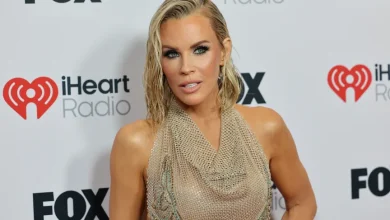Naomi Osaka Gets Real: Her Honest Post-Pregnancy Hair Journey Revealed

Naomi Osaka — a four-time Grand Slam champion, global icon, and one of the most influential athletes of her generation — has always been admired not only for her dominance on the tennis court but also for her authenticity off of it. Known for breaking barriers in sports and using her platform to discuss mental health, identity, and self-care, Osaka has now opened up about another deeply personal experience: her post-pregnancy hair journey.
In a refreshingly candid revelation, Naomi shared her struggles, insecurities, and triumphs in dealing with postpartum hair changes — a topic often overlooked yet widely experienced by new mothers worldwide. Her openness has sparked important conversations about beauty, self-acceptance, and the realities of motherhood beyond the spotlight.
This article takes a closer look at Naomi Osaka’s honest post-pregnancy hair journey, exploring what she’s revealed, the science behind postpartum hair loss, how she’s embraced her natural texture, and the empowering message she’s sending to women everywhere.
The Reality Behind Post-Pregnancy Hair Changes
Pregnancy can bring about some of the most dramatic transformations in a woman’s body — and the hair is no exception. Many women, including Naomi Osaka, experience noticeable changes in their hair texture, volume, and growth patterns after giving birth.
During pregnancy, higher estrogen levels often make hair appear thicker and shinier. However, after childbirth, when hormone levels normalize, many women experience postpartum hair shedding — a temporary but often distressing condition known as telogen effluvium.
This shedding can begin around three months after delivery and last for several months. For someone like Naomi, whose image is constantly under public scrutiny, navigating such changes can be emotionally challenging.
In a recent interview, Osaka admitted:
“I didn’t expect how much my hair would change after giving birth. It felt like a part of me that I had always known was suddenly different, and I had to learn to love it again.”
Her words reflect what many mothers experience — a complex mix of pride in their body’s strength and frustration with its unpredictable changes.
Naomi Osaka’s Journey into Motherhood
Before diving deeper into her hair transformation, it’s worth understanding the life changes Naomi has undergone in the past year.
In July 2023, Naomi Osaka and her longtime partner, rapper Cordae, welcomed their daughter, Shai. The tennis star, who had taken a break from the sport to focus on her pregnancy and mental health, expressed immense joy at becoming a mother.
Yet, she also acknowledged that motherhood came with challenges she didn’t anticipate. From sleepless nights to learning to balance her athletic career with parenting, Osaka has been refreshingly transparent about the ups and downs.
And among these experiences, one surprisingly emotional struggle was coming to terms with her post-pregnancy hair changes.
Naomi’s Honest Revelation: “It Wasn’t Just About Hair”
In an era where public figures are often expected to look flawless, Naomi Osaka’s openness about her postpartum hair journey feels revolutionary.
She revealed that after giving birth, she noticed her hair becoming thinner and more fragile, especially around her hairline — a common experience among new mothers due to hormonal fluctuations.
But for Osaka, the emotional impact went deeper than just appearance.
“For a long time, I tied a lot of my confidence to how my hair looked. When it started shedding, I felt like I was losing a part of myself,” she confessed.
Osaka’s statement resonated with many women who’ve felt the same — that post-pregnancy hair loss can sometimes feel symbolic of the identity shifts that motherhood brings.
The tennis star admitted she initially tried to hide her hair under hats and wigs. But over time, she realized that embracing her natural texture and giving her hair time to heal was a more empowering choice.
The Science Behind Postpartum Hair Loss
To understand Naomi’s experience, it helps to explore the biology behind postpartum hair loss.
During pregnancy, the surge in estrogen extends the growth phase (anagen) of the hair cycle, reducing the amount of shedding. That’s why many pregnant women notice thicker, fuller hair.
After childbirth, however, estrogen levels drop sharply. This causes a large number of hair follicles to enter the resting (telogen) phase simultaneously. A few months later, as these hairs shed, new mothers often notice significant hair fall — especially along the temples and hairline.
While the shedding phase is temporary, lasting between six months to a year, it can still be distressing.
Experts recommend gentle hair care practices, nutrient-rich diets, and patience as the body rebalances itself.
In Naomi Osaka’s case, her openness about this biological process helps normalize what so many women quietly experience.
Rediscovering Her Natural Hair Texture
Naomi Osaka has long been celebrated for embracing her natural curls — a defining part of her Japanese-Haitian heritage. However, like many women of mixed descent, she has had to navigate societal beauty standards that often favor straight hair.
Before pregnancy, Osaka frequently experimented with different hairstyles — from sleek ponytails to colorful braids and even straightened looks. But after giving birth, she began reconnecting with her natural curls in a deeper, more intentional way.
In one of her Instagram posts, she shared a photo with her natural hair on full display, captioning it:
“This is me — postpartum, healing, learning, and loving myself again.”
That simple post sparked an outpouring of support from fans and fellow mothers, who praised her for being real and relatable.
Naomi’s journey toward embracing her post-pregnancy hair wasn’t just cosmetic — it was symbolic of her evolving self-acceptance as a woman, mother, and athlete.
Her New Haircare Routine: Nurturing from Within
In several interviews and social media updates, Osaka discussed how her approach to haircare evolved after giving birth. Instead of focusing on appearance alone, she began prioritizing nourishment, patience, and self-care.
1. Embracing Minimalism
Rather than using harsh products or heat styling tools, Naomi focused on simplicity. She began using sulfate-free shampoos, hydrating conditioners, and leave-in treatments that promote moisture retention and reduce breakage.
2. Protective Styling
Osaka also turned to protective hairstyles such as braids and twists — not only as a fashion choice but to give her hair time to recover.
3. Nutrition and Hydration
Understanding the connection between health and hair, Naomi paid close attention to her post-pregnancy diet. Foods rich in iron, biotin, vitamin D, and omega-3 fatty acids became a regular part of her meals.
4. Scalp Care
She shared that she began practicing scalp massages with natural oils like argan and jojoba, which improve circulation and stimulate new growth.
Through these mindful habits, Naomi started seeing progress — not just in her hair’s strength but in her overall confidence.
Balancing Motherhood, Self-Care, and Career
One of the most admirable aspects of Naomi Osaka’s story is how she’s managing to balance motherhood with her return to professional tennis.
After taking nearly a year off, Osaka made her highly anticipated comeback in 2024, determined to show that women can pursue both motherhood and elite athleticism.
Still, she admitted that it hasn’t been easy.
“There are days when I feel strong and capable, and others when I’m just exhausted — mentally and physically. Learning to take care of myself, including my hair, has become part of how I find balance.”
Her words highlight an important truth: postpartum self-care isn’t vanity — it’s a form of self-preservation.
By taking care of her body, hair, and mental well-being, Naomi is setting an example for new mothers who often neglect themselves while caring for their newborns.
The Broader Conversation: Redefining Postpartum Beauty
Naomi Osaka’s transparency contributes to a broader cultural shift — one that challenges outdated notions of postpartum perfection.
Social media often bombards new mothers with unrealistic images of rapid “snapback” recoveries, flawless skin, and thick, glossy hair. Osaka’s openness offers a much-needed counter-narrative: that it’s okay to look and feel different after giving birth.
Her story reminds women that postpartum changes — including hair loss — are a natural part of healing, not something to be ashamed of.
Beauty, as Osaka shows, lies in authenticity and resilience, not in meeting impossible standards.
Celebrity Influence: Breaking the Silence Around Postpartum Hair Loss
Naomi Osaka joins a growing list of celebrities who have spoken out about postpartum hair challenges, helping to normalize the conversation.
- Chrissy Teigen, for instance, shared photos of her postpartum hair clumps, joking that she looked like she was “molting.”
- Beyoncé discussed losing her hair after giving birth to twins and how it impacted her sense of femininity.
- Serena Williams, Osaka’s longtime idol, has also spoken about hair and motherhood, emphasizing the importance of patience and self-love.
By joining these voices, Osaka helps dismantle the stigma around postpartum changes — using her global influence to promote empathy and realism.
Cultural Significance: Hair, Identity, and Representation
For Naomi Osaka, hair isn’t just about style — it’s about identity. As a biracial woman with Haitian and Japanese roots, her hair symbolizes the blending of two cultures that have historically held contrasting beauty ideals.
In Japan, where straight hair is often considered the norm, Osaka’s curls once sparked debates about identity and “Japanese-ness.” By embracing her natural texture — even through postpartum challenges — she’s making a powerful statement about self-acceptance and representation.
Her post-pregnancy hair journey, therefore, extends beyond motherhood; it’s part of her lifelong advocacy for authenticity and diversity in how beauty is defined.
What Naomi Osaka Teaches Us About Self-Love
Naomi Osaka’s candidness offers profound lessons about body acceptance and self-love:
- Change is natural. Postpartum transformations — from your body to your hair — are signs of growth, not loss.
- Healing takes time. Just like training for a comeback, self-care after childbirth requires patience and consistency.
- Authenticity empowers others. By being real about her struggles, Naomi empowers countless women to do the same.
- Confidence is internal. Beauty isn’t about returning to how things were before motherhood; it’s about embracing who you’ve become since.
Osaka’s message is clear: self-love isn’t about perfection — it’s about grace, acceptance, and growth.
The Road Ahead: New Beginnings On and Off the Court
As Naomi Osaka continues her comeback to tennis, she’s also embracing her evolving role as a mother, role model, and advocate for authenticity.
Her post-pregnancy hair journey may have started as a personal struggle, but it’s become an inspiring symbol of resilience and renewal.
Today, Naomi speaks proudly about the strength it took to accept her postpartum body and hair — and how that acceptance mirrors the mental fortitude she’s always displayed on the court.
“I’ve learned that every stage — in tennis, in motherhood, in life — has its own beauty. My hair will grow back, but what matters most is how I’ve grown as a person.”
Conclusion: Naomi Osaka’s Legacy of Realness
Naomi Osaka’s honest post-pregnancy hair journey is more than just a beauty story — it’s a reminder that even the strongest, most successful women face moments of vulnerability.
By sharing her experience, she’s destigmatizing postpartum struggles and redefining what it means to be beautiful, powerful, and real.
From her athletic achievements to her advocacy for mental health and now her openness about motherhood, Osaka continues to inspire millions with her authenticity.
Her journey reminds us all — whether we’re mothers, athletes, or simply navigating life’s transitions — that change is not something to hide, but something to embrace.




